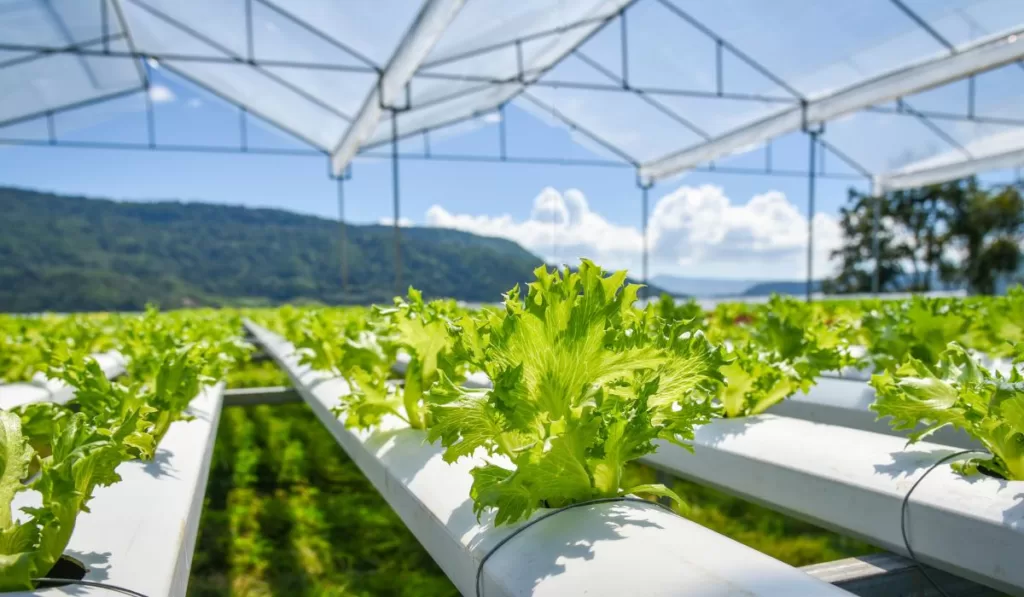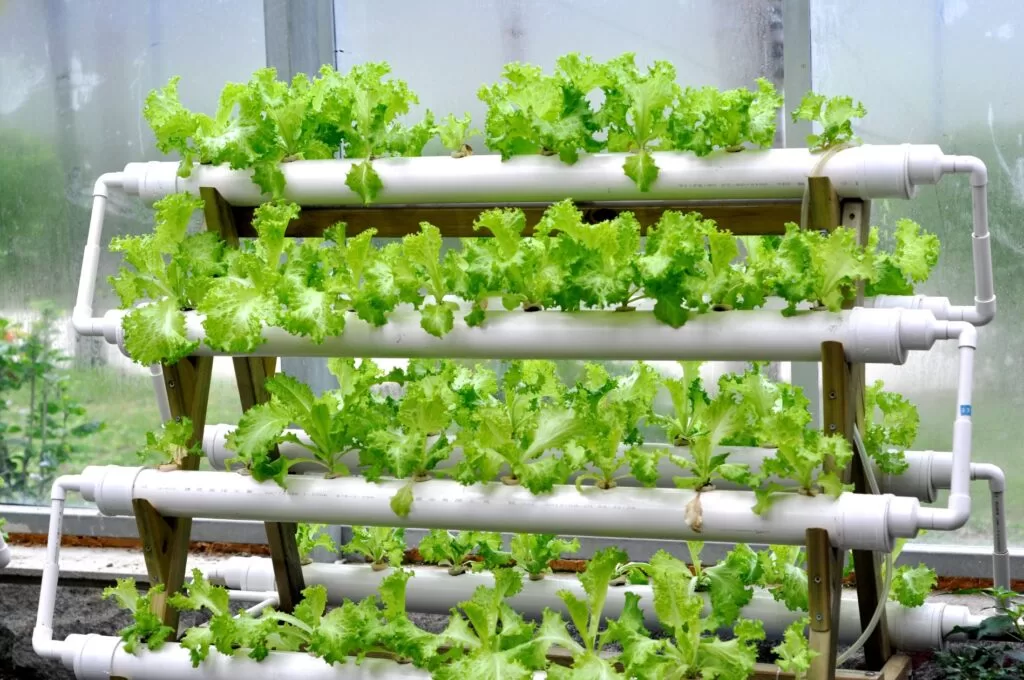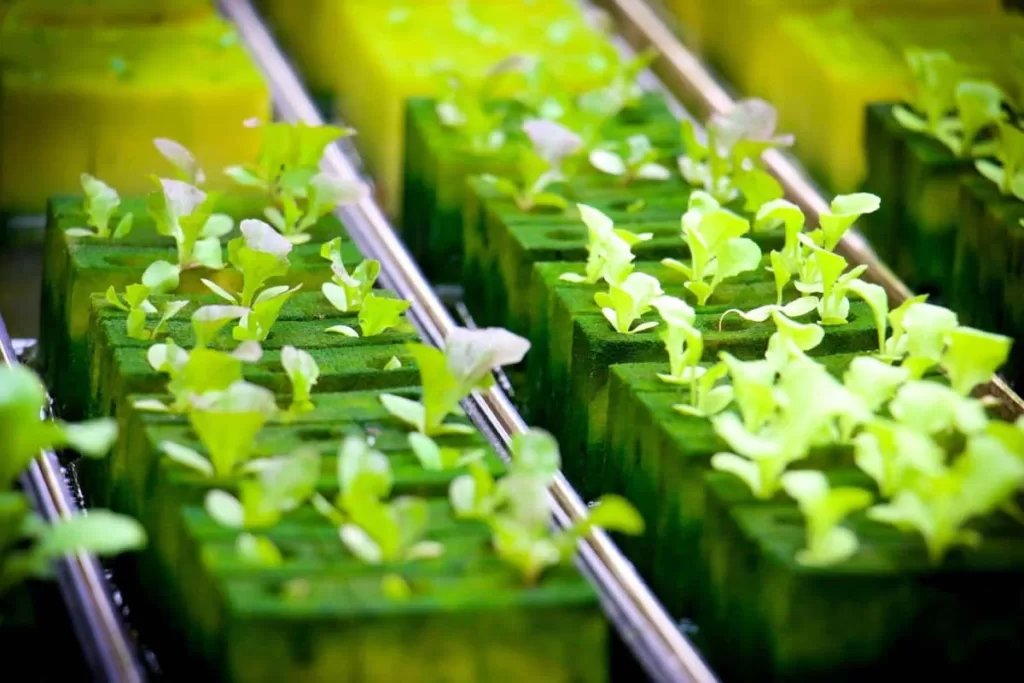The amount of water that hydroponic plants need per day will depend on the specific hydroponic system being used, the type of crop being grown, and the stage of growth. In general, hydroponic plants need to be kept consistently moist, but not waterlogged.
For example, in a deep water culture (DWC) system, plants are grown in a container of nutrient solution and the roots are submerged in the solution. In this system, the plants will need to be checked and the nutrient solution will need to be topped off daily to ensure that the roots are always submerged.
In a drip irrigation system, water and nutrient solution are delivered to the plants’ roots through a series of drippers or emitters, the plants will require less water than in a DWC. The frequency of watering will depend on the size of the container, the plant’s stage of growth, and the ambient temperature and humidity.
For example, young plants may need to be watered more frequently than mature plants, and plants grown in hot, dry conditions may need more water than those grown in cool, humid conditions. It’s important to monitor the plants and the hydroponic system closely and adjust the water and nutrient supply as needed.
It’s also important to note that a good practice is to periodically drain the system and refill it with fresh water and nutrient solution, this helps avoid the buildup of salts and other nutrients that can harm the plants.
Table of Contents

Is hydroponic vegetables safe?
Hydroponic vegetables are generally considered safe to eat as long as they are grown in a clean and sanitized environment and the water and nutrient solution used is free from harmful contaminants. Hydroponic systems can be designed to use a wide range of nutrient sources including fish or duck waste, human urine, and specially formulated hydroponic nutrient solutions. The safety of these systems will depend on the specific system and the source of the nutrients.
However, just like any other type of agriculture, hydroponics have some risks to consider, such as:
- Disease and pest control: Hydroponic systems can create an ideal environment for pests and diseases to thrive if not properly managed. Growers need to be vigilant in monitoring for and controlling pests and diseases to ensure the safety of the produce.
- Water quality: Hydroponic systems rely on water as the main element for growth, if the water is not clean or has pathogens it can compromise the produce’s safety.
- Sanitation: Hydroponic systems can harbor harmful bacteria, viruses, and other pathogens if not properly sanitized. Growers must take care to keep the systems clean and sanitized to ensure the safety of the produce.
- Nutrient balance: If the nutrient solution is not properly balanced, it can lead to nutrient deficiencies or toxic levels of certain elements, which can affect the safety and quality of the produce.
Overall, hydroponic vegetables can be considered safe to eat if they are grown in a clean and sanitized environment and the water and nutrient solution used is free from harmful contaminants. It’s important to monitor the system and the plants closely, and to use good agricultural practices to ensure the safety and quality of the produce.
What Cannot be grown hydroponically?
Some plants are not well-suited for hydroponic growing because they require specific growing conditions that are difficult to replicate in a hydroponic system, or because they have deep taproots that can’t be accommodated in a hydroponic setup. Examples of such plants are:
- Trees: Trees have deep taproots that can’t be accommodated in most hydroponic systems, and they also need a lot of space to grow.
- Root vegetables: Root vegetables like carrots, beets, and potatoes need deep soil to grow in, and their long taproots can be difficult to accommodate in a hydroponic system.
- Plants that require specific soil conditions: Some plants require specific soil conditions to grow, such as acidity or alkalinity levels, that are difficult to replicate in a hydroponic system.
- Plants that are sensitive to water-soluble salts: Certain plants are sensitive to the buildup of water-soluble salts in the nutrient solution, which can occur in hydroponic systems.
- Plants that require pollination: Some plants require pollination in order to produce fruit, and hydroponic systems can make it difficult to achieve this.
However, it’s worth noting that with the advancements in technology and the development of new hydroponic systems, the range of plants that can be grown hydroponically has increased. Many plants that were once considered difficult or impossible to grow hydroponically are now being successfully grown in hydroponic systems.
How long is a hydroponic grow cycle?
The length of a hydroponic grow cycle will depend on the specific crop being grown and its growth habits. Some plants have a shorter grow cycle, while others have a longer grow cycle.
For example, most leafy greens such as lettuce, spinach, and arugula can be grown to maturity in as little as 4-6 weeks. Herbs like basil, parsley, and cilantro typically take 6-8 weeks to mature.
On the other hand, plants like tomatoes, peppers, and cucumbers typically have a longer grow cycle. They can take anywhere from 8-12 weeks to reach maturity, depending on the variety and the growing conditions.
Flowering plants like cannabis, can take between 8-12 weeks for the vegetative stage and another 8-12 weeks for the flowering stage, this can vary depending on the strain and the environment.
It’s important to note that the length of the grow cycle will also depend on the specific hydroponic system and growing conditions. In a well-designed hydroponic system with optimal environmental conditions, plants may grow faster than they would in soil.
In general, a hydroponic grow cycle can vary between 4-16 weeks, but it can be shorter or longer depending on the specific plant and its growth habits.

What are 4 benefits of hydroponics?
- Increased Efficiency: Hydroponic systems use less water and nutrients than traditional soil-based farming, and they can produce a higher yield per square foot of growing space. This means that hydroponics can be a more efficient and sustainable way to grow crops.
- Control of Growing Conditions: Hydroponic systems allow growers to closely control the environment in which plants are grown. This includes temperature, humidity, light, and nutrient levels, which can be adjusted to optimize growth and productivity.
- Year-Round Production: Hydroponic systems can be used to grow plants indoors, which means that they can be used to produce crops all year round, regardless of the weather or season.
- Reduced Pest and Disease Pressure: By growing plants in a controlled environment, hydroponic systems can reduce the risk of pest and disease pressure, which can lead to healthier plants and higher yields. Additionally, hydroponic systems can be designed to use natural predators to control pests, this can reduce the use of pesticides and chemicals.
- Flexibility: Hydroponics can be used to grow a wide variety of crops, from leafy greens to fruits and vegetables, and it can be adapted to different spaces, from small indoor gardens to large commercial operations.
- Reduced water usage: Hydroponics can reduce water usage significantly, as the water is reused and recirculated. This is especially important in areas where water is scarce or where the cost of water is high.
- Space-saving: Hydroponics can be used in places where soil is not available or where space is limited, such as urban areas, rooftop gardens, and vertical farms.
What are 5 disadvantages of hydroponics?
- High Initial Investment: Hydroponic systems can be expensive to set up, especially for large-scale commercial operations. The cost of equipment, such as lights, pumps, and nutrient solutions, can be significant.
- Technical Knowledge: Hydroponic systems require a certain level of technical knowledge to set up and maintain. Growers need to understand how to balance the pH and nutrient levels in the water, as well as how to properly care for the plants in a controlled environment.
- Power Requirements: Hydroponic systems often rely on electricity to power lights, pumps, and other equipment, which can be costly and can also be affected by power outages or other disruptions.
- Potential Pest and Disease Issues: While hydroponic systems can reduce the risk of pest and disease pressure, they can also create a perfect environment for certain pests and diseases to thrive if not properly maintained.
- Limited Plant Selection: Hydroponics may not be suitable for all plants, as some plants require specific soil conditions or have deep taproots that can’t be accommodated in a hydroponic setup. Additionally, some plants may require pollination, which can be difficult to achieve in a hydroponic system.
- Dependence on technology: Hydroponics is dependent on technology, which means that if something goes wrong, it can be difficult to fix, and it can also be costly to replace or repair.
- Lack of Diversity: Hydroponics systems are usually monoculture, which means that only one type of plant is grown in a specific system, this can lead to lack of biodiversity and a reduction in resilience.

Are hydroponic nutrients harmful?
Hydroponic nutrients, when used correctly, are not harmful to plants or humans. However, it’s important to note that like any agricultural product, hydroponic nutrients are chemicals and should be handled with care and used according to the manufacturer’s instructions. Improper use or handling of hydroponic nutrients can lead to plant damage or even harm to human health.
It is important to note that hydroponic nutrients are not the same as organic fertilizers, as hydroponic nutrients are specifically formulated for hydroponic systems and are made from synthetic compounds. Some people may have concerns about the safety or environmental impact of these synthetic compounds.
It’s recommended to use high-quality, well-researched hydroponic nutrient brands that have undergone strict testing to ensure their safety and effectiveness. It is also important to regularly test and adjust the nutrient levels in the hydroponic solution to ensure that plants are getting the right balance of nutrients.
In conclusion, hydroponic nutrients can be safe to use when handled and used properly, but it’s important to be aware of the potential risks associated with improper use, and to take appropriate safety precautions.
Why are my hydroponic plants dying?
There can be many reasons why your hydroponic plants are dying, some of the most common causes include:
- Nutrient Deficiencies: Plants require a balance of essential nutrients, such as nitrogen, phosphorus, and potassium, to grow and thrive. If the hydroponic solution is not properly balanced, the plants may not be getting the nutrients they need, leading to stunted growth or death.
- pH Imbalances: The pH level of the hydroponic solution should be within a specific range for plants to absorb nutrients effectively. If the pH level is too high or too low, the plants may not be able to absorb the necessary nutrients, leading to poor growth or death.
- Temperature and Light: Hydroponic plants require specific temperature and light conditions to grow properly. If the temperature is too high or too low, or if the plants are not getting enough light, they may become stressed and die.
- Overwatering or Drowning: Overwatering or drowning plants can lead to root rot, which can kill the plants. It is important to monitor the water level in the hydroponic system and ensure that the plants are not sitting in water for too long.
- Pest or Disease: Pests and diseases can also affect hydroponic plants. It’s important to monitor the plants for signs of infestation and take action promptly to prevent the spread of pests or diseases.
- Air circulation: Poor air circulation can lead to stagnant air, which can cause mold and mildew to grow, leading to plant death.
It is important to regularly check the pH, temperature and nutrient levels in your hydroponic system, to make sure they are within the optimal range, monitor the plants for signs of pests or diseases, and take appropriate action promptly. If the problem persists, it may be helpful to consult with a professional in hydroponics.





